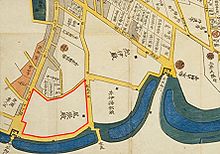Tokugawa (Owari)
The Owari-Tokugawa ( Japanese 尾張 徳 川 家 , Owari Tokugawa-ke ) were one of the three families that descended from the youngest sons of Tokugawa Ieyasu and thus belonged to the Shinpan daimyō . With an income of 250,000 koku , they were the largest of the three branch families ( gosanke ).
The family's art treasures are on display at the Tokugawa Art Museum. The family's property is now managed by the Tokugawa Reimeikai ( 徳 川黎明 会 ) charitable foundation , chaired by the head of the Owari-Tokugawa.
genealogy
Main line
- Yoshinao ( 義 直 , 1600–1650), seventh son of Tokugawa Ieyasu , received the Fuchū ( Suruga ) fief in 1603 with 250,000 koku. In 1607 he was transferred to Kiyosu ( Owari ) with 555,000 koku. Ieyasu built Nagoya Castle , which Yoshinao took over in 1610. He and his descendants resided there with 619,500 Koku until 1868.
- Yoshikatsu ( 慶 勝 , 1824-1883) was the last daimyo of this line. After 1868 he received the title of Prince .
Matsudaira (Owari)
- Matsudaira Yoshiyuki ( 松 平 義 行 , 1641-1711), a grandson of Yoshinao, received the fief of Takasu ( 高 須 藩 , Mino ), where he and his descendants resided until 1868 in a permanent house ( jinya ) with an income of 30,000 koku. After 1868 Vice Count.
- Matsudaira Yoshimasa ( 松 平 義昌 , 1651-1713), another grandson of Yoshinao, received the fiefdom of Yanagawa ( 梁川藩 ) ( Mutsu ), where he and his descendants resided until 1729 in a permanent house with an income of 30,000 koku. Then the incumbent daimyo continued the main line in Nagoya as Tokugawa Muneharu (1696–1764) .
literature
- Papinot, Edmond: Historical and Geographical Dictionary of Japan. Reprinted by Tuttle, 1972 edition of 1910 edition. ISBN 0-8048-0996-8 .
- Miura, Masayuki (Ed.): Shiro to jinya. Tokoku-hen. Gakken, 2006. ISBN 978-4-05-604378-5 .
- Miura, Masayuki (Ed.): Shiro to jinya. Saikoku-hen. Gakken, 2006. ISBN 978-4-05-604379-2 .
- Miyaji, Saichiro (Ed.): Bakumatsu shoshu saigo-no hanshu-tachi. Nishinihon-hen. Jinbunsha, 1997. ISBN 978-4-7959-1906-8 .
Web links
- Tokugawa Reimeikai website (Japanese)
Remarks
- ↑ Today the Japanese Ministry of Defense is located there . Before that there was a barracks, the place of Mishima Yukios Seppuku .
- ↑ This district is called Ki-OI-cho after the secondary residences of the Kishū-Tokugawa , Owari-Tokugawa and Ii . Today the big Hotel New Otani stands there .
- ↑ Today a district of Kaizu .


